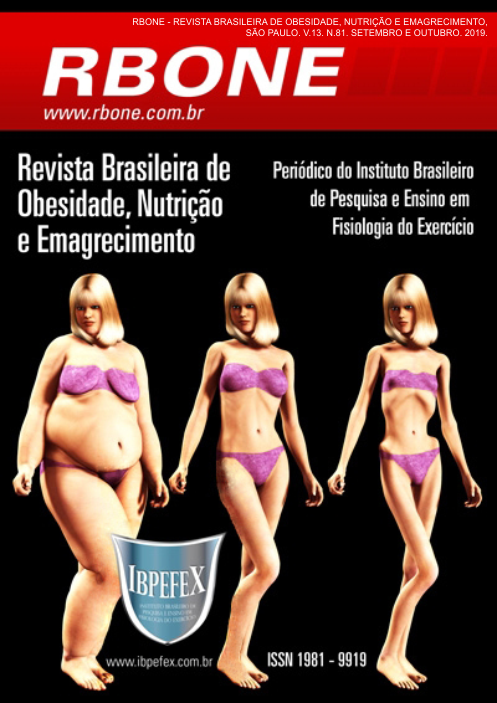Intake of green tea and matcha in the anthropometric profile and biochemical parameters
Abstract
The obese condition, characterized by excess accumulation of body fat, has a high incidence in the population becoming a public health problem. In view of this, there is a need to adopt strategies to assist in its fight against chronic noncommunicable diseases (CNCD) associated with it. An alternative are foods that have bioactive compounds, such as green tea that can aid in the oxidation of fat, due to the concentration of catechins. In addition to the green tea - just the infusion of the leaves - another type of tea also originating from Camellia sinensis gains attention in the oxidation of lipids: the matcha, made from the complete maceration of the leaves. Research has shown that it may have 137 times more polyphenols, of the epigallocatechin-3-gallate type (EGCG), compared to traditional green tea. The objective of this work is to compare the efficacy of matcha and green tea as lipolytic agents, administered daily in non-practitioners of physical activity, without restricted diet, for 40 days. Two groups were analyzed - green tea (GCV) and matcha (GM), with ten people each. Biochemical and anthropometric analyzes of the participants were performed. Among the results, we highlight the reduction of serum glucose levels in both groups, both with level of significance ** p <0.01 for the student t test. EGCG is believed to inhibit the activity of the intestinal glucose transporter, leading to reduced uptake of glucose into the intestine. Therefore, green tea and matcha can be used to decrease glycemia and other complications of obesity. In both groups, there was also a decrease in body weight, in addition to free fat, but without statistical relevance.
References
-Agência Nacional de Vigilância Sanitária (ANVISA). Guia para Comprovação da Segurança de Alimentos e Ingredientes (2013). Brasília. Acessado em 02/02/2019 em http://portal.anvisa.gov.br/documents/33916/ 395734/Guia+para+Comprovação+da+Segurança+de+Alimentos+e+Ingredientes/f3429948-03db-4c02-ae9c-ee60a593ad9c
-Hasler, C.M. Functional foods: benefits, concerns and challenges -a position paper from the american council on science and health. The journal of nutrition. Vol. 132. Núm. 12. p. 3772-3781. 2002.
-Hursel, R.; Viechtbauer, W.; Westerterp-Plantenga, M.S. The effects of green tea on weight loss and weight maintenance: a meta-analysis. Int J Obes (Londres). Vol. 33. p. 956-61. 2009.
-Janssen, P.L.H.R.; Hursel, R.; Plantenga, M.S.W. Long term green tea extract supplementation does not affect fat absorption, resting energy expenditure, and body composition in adults. The journal of nutrition. Vol. 145. Núm. 5. p. 864-870. 2015.
-Kao, C.C.; Wu, B. T.; Tsuei, Y. W.; Shih, L. J.; Kuo, Y. L.; Kao, Y, H. Green tea catechins: inhibitors of glycerol-3-phosphate dehydrogenase. Planta Medica: natural products and medical plant research. Stuttgart. Vol. 76. 694-696. 2010.
-Lamarão, R. C.; Fialho, E. Aspectos funcionais das catequinas do chá verde no metabolismo celular e sua relação com a redução da gordura corporal. Revista de Nutrição. Vol. 22. Núm. 2. 2009.
-Maruyama, K.; Iso, H.; Sasaki, S.; Fukino, Y. The association between concentrations of green tea and blood glucose levels. Journal Clin. Biiochem. Nutri. Vol. 44. p. 41-45. 2009.
-Nagao, T.; Hase, T.; Tokimitsu, I. A green tea extract high in catechins reduces body fat and cardiovascular risks in humans. Obesity. Vol. 15. Núm. 6. p. 1473-1483. 2007.
-Pereira, R. A relação entre dislipidemia e diabetes mellitus tipo 2. Cadernos UniFOA. Volta Redonda. Ano VI. Núm. 17. 2011.
-Instituto Brasileiro de Geografia e Estatística. Pesquisa Nacional de Saúde: Brasil e grandes regiões. Rio de Janeiro: Instituto Brasileiro de Geografia e Estatística. 2015.
-Santos, C.B.; Bernardino, G.Z.; Soares, F.J.; Espindola, J.D.; Arruda, P.M.R.; Paula, J.R.; Conceição, E.C.; Bara, M.T.F. Preparo e caracterização de tinturas das folhas de chá verde. Revista brasileira de plantas medicinais. Vol. 16. Núm. 4. p. 826-831. 2014.
-Schiavo, M.; Lunardelli, A.; Oliveira, J.R. Influência da dieta na concentração sérica de triglicerídeos. Jornal Brasileiro de Patologia e Medicina Laboratorial. Vol. 39. Núm. 4. p. 283-288. 2003.
-Shan, D.; Fang, Y.; Liu, J. EGCG reducing the susceptibility to cholesterol gallstone formation the regulation of inflammation. Biomedicine & Pharmacotherapy. Vol. 62. Núm. 10. p. 677-683. 2008.
-Shixian, Q.; Vancrey, B.; Shi, J.; Kakuda, Y.; Jiang, Y. Green tea extract thermogenesis-induced weight loss by epigallocatechin gallate inhibition of Catechol-O-Methyltransferase. Journal of Medicinal Food. New York. Vol. 9. Núm. 4. p. 451-458. 2006.
-Suzuki, T.; Pervin, M.; Goto, S.; Isemura, M.; Nakamura, Y. Beneficial effectsof tea and the green tea catechin epigallocatechin-3-gallate on obesity. Molecules. Vol. 21. Núm. 10. 1305. 2016.
-Weiss, D.J.; Anderton, C.R. Determination of catechins in matcha green tea by micellar electrokineticchromatography. J Chromatogr A. Vol. 5. Núm. 1-2. p. 173-8. 2013.
-Xu, P.; Ying, L.; Hongb, G.; Wang, Y. The effects of the aqueous extract and residue of Matcha on the antioxidante status and lipid and glucose levels in mice fed a high-fat diet. Food Funct. Vol. 7. p. 294. 2016.
-Wright, E.M.; Martín, M.G.; Turk, E. Intestinal absorption in health and disease-sugar. Best Pract Res Clin Gastroenterol. Vol. 17p. 943-56. 2003.
Copyright (c) 2020 Ligia Prestes Fernandes, Humberto Moreira SpÃndola, Flavia Noeli de Souza Infante, Juliana Burger Rodrigues

This work is licensed under a Creative Commons Attribution-NonCommercial 4.0 International License.
Authors who publish in this journal agree to the following terms:
- Authors retain the copyright and grant the journal the right of first publication, with work simultaneously licensed under the Creative Commons Attribution License BY-NC which allows the sharing of the work with acknowledgment of the authorship of the work and initial publication in this journal.
- Authors are authorized to enter into additional contracts separately for non-exclusive distribution of the version of the work published in this journal (eg, publishing in institutional repository or book chapter), with acknowledgment of authorship and initial publication in this journal.
- Authors are allowed and encouraged to post and distribute their work online (eg, in institutional repositories or on their personal page) at any point before or during the editorial process, as this can bring about productive change as well as increase impact and impact. citation of published work (See The Effect of Free Access).






